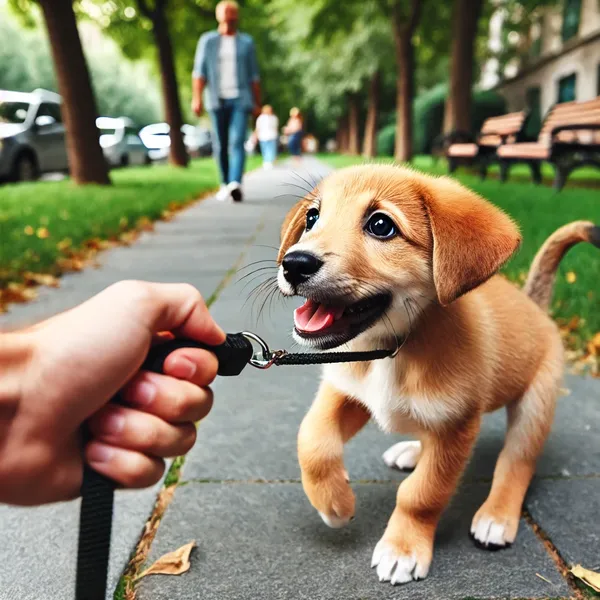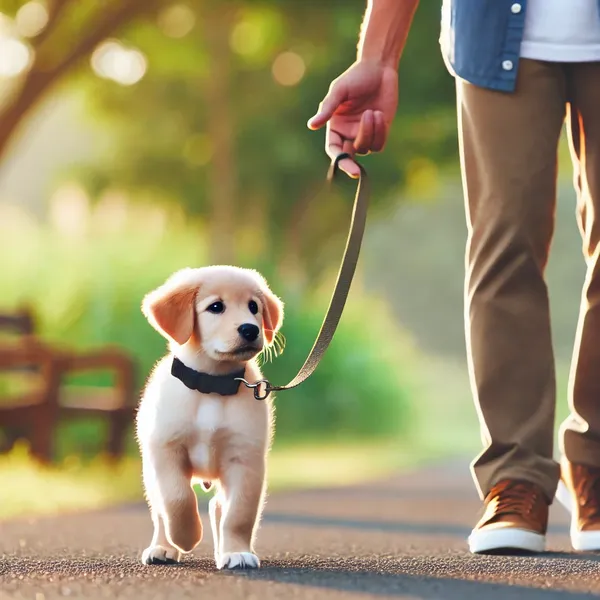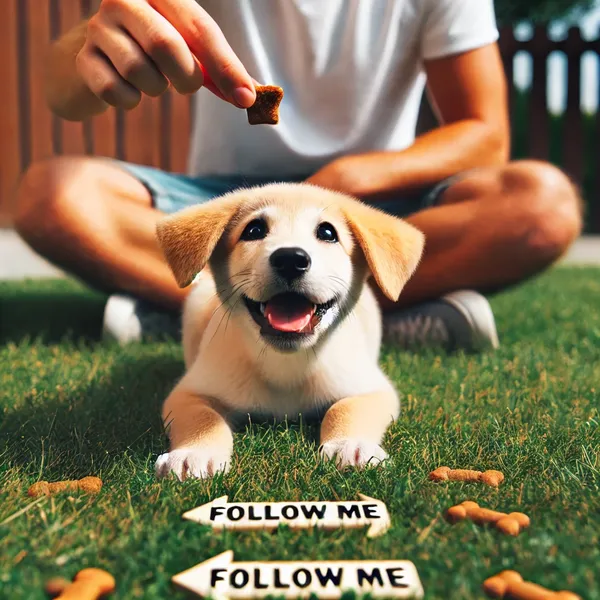How to teach a puppy to walk on a leash without pulling? Guiding a pet and, even more so, a puppy to walk nicely on lead is one of the essential skills to share.
Anyone who has ever attempted to walk a puppy understands all too well the phenomenon of going out only for the puppy to walk the owner. The beauty and the twist! There is a way to teach a dog to relax and walk next to you with the help of time and a few simple techniques.
Here, we will again (pun intended) provide a detailed step-by-step guide on how you will go about teaching your pup to heel while on a leash. And do not worry; we shall make things pleasant and simple, as it should be the process of teaching your puppy!
Why Puppies Tend To Pull on the Leash

Let us address how we can stop it. First, it would be good to clarify why puppies pull so much on a leash attached to their necks.
Every puppy is a little bundle of energy and curiosity. They want to see more, hear more, and smell more, and most things, sight, sound, or odor, are simply compelling.
It is pulling that takes place because something has captured their interest, and they want to quicken their pace in order to reach it.
Because they walk not beside you, but a little ahead of you, they simply have not understood that they will have to remain quiet and by your side!
What You’ll Need for Leash Training

When you are ready, ensure you have the following equipment and supplies to begin leash training your puppy.
- An adjustable collar or a harness: Most puppies enjoy using a harness, as it eases the pressure on the neck from the leash.
- A normal dog leash: Do not use a leash that stretches the distance as they promote pulling.
- Dog treats: Food is the main motivator for most puppies, and treats are invaluable rewards when training.
Above all, patience and consistency are equally crucial as physical tools. Also, beware: Training is not achieved in one day!
How to Teach a Puppy to Walk on a Leash Without Pulling

Step-by-Step Guide to Teach Your Puppy Not to Pull
1. Start Indoors
Before you step on the tarmac, make sure that the puppy understands that the leash does not denote a walking stick. This will enable the puppy to favorite the leash when most stimuli are controlled.
Attach the leash to the harness or the collar of the puppy.
Walk a few paces and beckon your puppy to follow.
When she walks to her heel without pulling, immediately give a treat pass or entice her with a snack.
Remember to limit these sessions to a few minutes only. Puppies have a very short attention span, so it is more effective to carry out a number of short sessions within the day.
2. Positive reinforcement
Often, puppies are rewarded for good deeds. That means rewards – something puppies like (for instance, treats or praise) are offered when doing something right.
For instance, when the puppy walks beside you, calmly praise it and treat it as ‘good job.’
Danger: Do not take too much time to reward! Puppies have to know when they are right or what they did that was right.
3. When They Pull, Try To Stop Them
Another technique that works well to prevent a young dog from pulling a leash is to explain that tension on a leash is not rewarded with progress.
If your pet starts pulling on the lead, come to a halt. No yanking or pulling them back; just cease. Allow the leash to go loose before resuming walking.
This way, the puppy will come to learn that tugging at the leash will not lead to what they wish for, in this case, progression.
Do: As the leash becomes taut, come to a halt.
Do not Allow your puppy to yoke you up.
Expect this to take a little more time than the others due to its level of frustration. However, stick to it. Soon, your puppy will learn that pulling is not the answer.
4. Keep the Walks Pleasantly Brief in the Beginning
In the initial stages of training, avoid dragging the puppy for long walks. As previously stated, every pup gets tired after some time rather than being accustomed to being on a leash for hours.
Therefore, always try to help the pup with the leash walk. As the puppy familiarizes themself with leashed walking without pulling, lengthen the duration of the short walks.
5. Turn about
If your puppy pulls towards something, turn around and walk the other way. This directs the pup’s focus back on the walker and encourages the pup to be close to them. Infants can be kept interested by often switching, and always pulling ahead is avoided.
For instance, Let’s say a puppy wants to sniff a tree and begins to pull; the owner should turn around and face the opposite direction.
6. Clicker Training
Trainers suggest using a clicker to teach the appropriate time to perform a task. For instance, you can use a clicker for punishment and offer a reward after your puppy walks beside you without pulling.
In the process, the puppy will learn that a sound (clicking noise) emphasizes a desirable action and a treat that follows.
7. Never Forget to Be Understanding
One does not expect the puppy to instantly understand that they must walk politely with the leash. It requires tolerance, a lot of repeating, and especially – discipline.
Do not feel bad if the dog cannot grasp the task immediately. Keep reinforcing the same techniques where positive reinforcement is used.
8. Relax
Your dog understands your feelings. Therefore, if you are irritated, your puppy will get more jitters or hyperactivity, thus aggravating the pulling.
Therefore, it is critical to be composed and still during the walks. If things are not going well, it is fine to step away from the activity and come back another time.
Common Mistakes and How to Avoid Them
When you are a novice working on leash training your pup, chances are high that you may commit one or two errors. The following are some mistakes and the ways of circumventing them:
|
Mistake |
How to Avoid |
| Using a retractable leash | These leashes encourage pulling because they teach puppies that pulling gets them more freedom. Use a standard leash instead. |
| Not being consistent | If you sometimes let your puppy pull and sometimes don’t, they’ll get confused. Make sure to always stop when they pull. |
| Walking for too long | Long walks can overwhelm a young puppy. Keep walks short in the beginning and gradually increase the length as your puppy gets better at walking calmly. |
| Punishing pulling | Yanking or scolding your puppy can make them fearful or anxious. Stick with positive reinforcement, which will be more effective in the long run. |
Games to Help Your Pet Develop Leash Skills

All the training does not have to be so severe. You can have fun while leash training by playing some games.
1. ’Follow Me’ Game
In an area that is free of distractions, take a few steps in one direction. Once your puppy continues in that direction, give a treat reward. Repeat with the opposite direction. This game is excellent at teaching puppies to pay attention and remain on the owner, which is handy when walking the puppy.
2. The ‘Red Light, Green Light’ Game
This game is just like the childhood game of the same name, except this one comes with a leash. Start with the puppy walking next to you. As soon as the puppy pulls ahead of you, come to a halt (red light). Return to motion when the puppy returns or the leash becomes loose (green light). This teaches the puppy that pulling equals a cessation of the fun.
When to Get Help from a Trainer
At times, leash training may still be a problem with your puppy after all your attempts. Even worse, if your puppy is very reactive to things likely causing them to pull, it is advisable to consult a dog training expert. A trainer will offer you additional help specific to your case and aid your puppy in overcoming the unwanted behavior.
Summation of the Main Ideas
Below, we explain the main points that you will need to consider when walking your pup on a leash without any pulling:
- Start indoors: Allow your pup to exercise on a leash, walking in a place free of distractions.
- Employ treats and praise: Reinforce your pup whenever he walks beside you.
- Stop pulling immediately: In case your pup tugs, freeze. Walk only after the leash goes loose.
- Keep them short walks: Most appropriate, extend the walking time as the puppy gets better.
- Change direction frequently: Keep your puppy engaged with you by turning your body.
- Be calm and persistent. Puppies learn at a slow pace, so do not hurry the process.
- Remain cool: Your feelings affect your puppy’s actions, so make it as cool as possible.
Conclusion
Getting a puppy to walk on a leash without pulling requires patience, practice, and insistence. If you employ positive reinforcement and stop whenever they pull, they will quickly learn that walking next to you is the best option. Don’t forget that you also have to make things easy and ensure you and the puppy enjoy the experience. Before long, with practice, walks will be effortless, and you two will relish the time spent together outside.
Leash training might take some time, but it is a valuable skill for you and your puppy. Ts snacks and children’s leashes! Go on, kids; it’s time to teach your little friend to take those lovely walks without fuss!